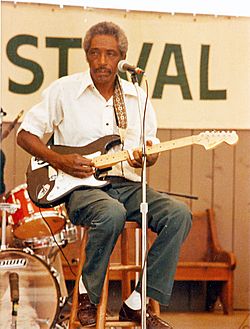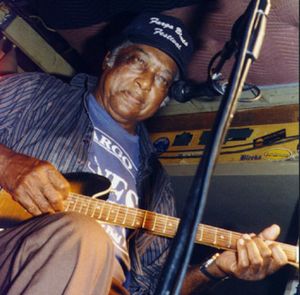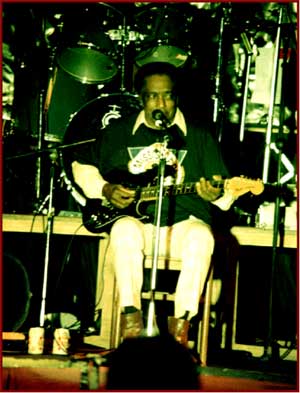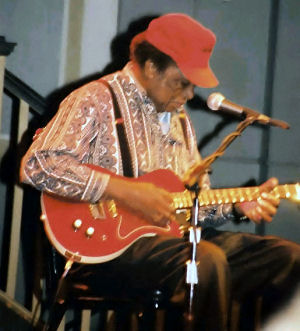R. L. Burnside facts for kids
Quick facts for kids
R. L. Burnside
|
|
|---|---|

Burnside performing in Knoxville, Tennessee, at the 1982 World's Fair
|
|
| Background information | |
| Born | November 23, 1926 Harmontown, Lafayette County, Mississippi, U.S. |
| Origin | Oxford, Mississippi |
| Died | September 1, 2005 (aged 78) Memphis, Tennessee |
| Genres |
|
| Instruments | Guitar, vocals |
| Years active | 1960s–2005 |
| Labels | Fat Possum |
| Associated acts | Calvin Jackson, Jon Spencer |
R. L. Burnside (born November 23, 1926 – died September 1, 2005) was an American blues musician. He was a singer, songwriter, and guitarist. Burnside played music for most of his life. However, he did not become widely known until the early 1990s. Later, he worked with musician Jon Spencer. This helped his music reach new fans, including those who liked punk and garage rock.
Contents
Life and Music Career
Early Years: 1926–1959
R. L. Burnside was born in 1926 in rural Lafayette County, Mississippi. His first name is sometimes written as Rural, Robert Lee, or Ruel. His father left the family when R. L. was young. He grew up with his mother, grandparents, and siblings.
He started playing the harmonica and guitar around age 16. He said his first public performance was when he was 21 or 22. Burnside learned a lot from Mississippi Fred McDowell. McDowell lived near Burnside since he was a child. R. L. first heard McDowell play at age 7 or 8. He later joined McDowell's shows to play a late set.
Other local teachers included his uncle-in-law Ranie Burnette. Burnside also mentioned church singing and fife-and-drum picnics. He said Muddy Waters, Lightnin' Hopkins, and John Lee Hooker influenced his music.
In the late 1940s, Burnside moved to Chicago. He hoped to find better jobs there. He worked in factories and enjoyed the blues music scene. However, it was a tough time for him. Within one year, his father, two brothers, and two uncles died.
Three years later, Burnside returned to the South. He married Alice Mae Taylor in 1949 or 1950. This was his second marriage. In the 1950s, he moved often. He lived in Memphis, Tennessee, the Mississippi Delta, and northern Mississippi. During this time, he met blues musicians Robert Lockwood Jr. and Aleck "Rice" Miller.
Part-Time Musician: 1960–1990
For the next 45 years, Burnside lived in northern Mississippi. He worked as a sharecropper, growing cotton and soybeans. He also worked as a commercial fisherman and a truck driver. Later, he moved closer to Holly Springs. After returning to Mississippi, he played more local shows. He performed in juke joints, bars, picnics, and at his own house parties.
His first recordings were made in 1967 by George Mitchell. Mitchell was a journalism student. He recorded Burnside at his home near Coldwater, Mississippi. Six of these songs were released two years later. Another album of acoustic songs was recorded in 1969.
These early recordings featured Burnside playing acoustic guitar and singing. Some tracks had harmonica. By this time, Burnside also played electric guitar. His music included songs from the hill country and Memphis. He also covered songs by John Lee Hooker and Muddy Waters.
In 1969, he performed outside the United States for the first time. He played in Montreal with Lightnin' Hopkins and John Lee Hooker. As a solo artist, he toured Europe three times. He played for excited audiences. In 1974, he performed at the New Orleans Jazz & Heritage Festival. He played at this festival nine times in total.
Also in 1974, Tav Falco filmed Burnside. This was at the Brotherhood Sportsmen's Lodge, a juke joint Burnside ran. His performance included slide guitarist Kenny Brown. Kenny Brown was Burnside's friend and student. Burnside started teaching him in 1971. In 1978, Alan Lomax filmed Burnside for a TV documentary.
In 1979, music expert David Evans recorded Burnside. These recordings were the first to feature Burnside's Sound Machine. This band included his sons Duwayne and Daniel on guitar, Joseph on bass, and his son-in-law Calvin Jackson on drums. The band played a mix of rural and urban blues, funk, R&B, and soul. This style appealed to young people in Mississippi.
From 1980 to 1986, Burnside recorded for Dutch and French labels. He mostly played solo or with harmonica. These recordings focused on hill country music. They also included songs by Lightnin' Hopkins, Muddy Waters, and John Lee Hooker. These led to four more album releases in Europe.
In the mid-1980s, Burnside stopped farm work. He became more focused on music. He worked with harp player Jon Morris Neremberg for about 12 years. He performed for American audiences at events like the 1982 World's Fair. By the mid-1980s, he was touring Europe often.
Commercial Success: 1991–2005
In the late 1970s or early 1980s, Burnside met Junior Kimbrough. They became partners. Burnside's own "Burnside Palace" closed down. His family then lived near Kimbrough's "Junior's Place." They worked together on music. The music writer Robert Palmer visited this scene. This led to the 1990 documentary Deep Blues. Burnside was a main feature in this film.
Burnside began recording for Fat Possum Records in 1991. This label recorded older north Mississippi bluesmen. It was started by two students who had seen Burnside play. Burnside stayed with Fat Possum until his death. Their first album was Bad Luck City (1992). The next, Too Bad Jim (1994), was recorded at Junior's Place. It was produced by Robert Palmer. After his son-in-law Calvin Jackson moved, Burnside formed a new band. He usually performed with Kenny Brown and his grandson, drummer Cedric Burnside.
At a concert in New York, Burnside caught the attention of Jon Spencer. Spencer was the leader of the Jon Spencer Blues Explosion. Burnside started touring with this group in 1995. He was an opening act and also joined their jam sessions. This helped him gain many new fans. The 1996 album A ... Pocket of Whiskey was recorded with Spencer's band. It was praised by critics and musicians like Bono and Iggy Pop. Billboard magazine said it sounded like no other blues album.

After working with the Blues Explosion, his label started making remixed music. Producer Tom Rothrock remixed Burnside's recordings. This was done to appeal to techno, downtempo, and hip-hop listeners. This experiment started with a track in Mr. Wizard (1997). It became a full album with Come On In (1998). Burnside liked the final product, especially because it was popular.
Burnside continued to tour a lot. He opened for the Beastie Boys. He was a musical guest on TV shows like Late Night with Conan O'Brien. He also performed at private events. Junior's Place, a popular music spot, burned down in 2000.
More documentaries were made about his life and work. Bradley Beesley filmed Hill Stomp Hollar. This film was about Burnside and other Fat Possum artists. Much of Beesley's footage was used in You See Me Laughin' (2003). This film was directed by Mandy Stein. In 1999, French blues singer Sophie Kay filmed a documentary about Burnside.
Burnside's health began to decline. He had an ear infection and heart surgery in 1999. As his tours became less frequent, Wish I Was In Heaven Sitting Down (2000) was released. This album featured other guitar players. After a heart attack in 2001, his doctor advised him to make health changes. Burnside followed this advice. Fat Possum released A Bothered Mind (2004). This album used older guitar tracks. It also included collaborations with Kid Rock and Lyrics Born.
These remixed albums received mixed reviews. Some found them "unnatural," while others liked their playful spirit. The remixes were successful. They appeared on Billboard's Top Blues Albums chart. Two songs from Come On In were on The Sopranos' soundtrack. "Let My Baby Ride" was played a lot on the radio. "Rollin' & Tumblin'" was used in a 2002 Nissan TV commercial. However, the live album Burnside on Burnside (2001) was also very popular. It was nominated for a Grammy. This album was recorded in 2001 with Kenny Brown and Cedric Burnside.
Fat Possum also released First Recording (2003). This album had George Mitchell's 1967 recordings. Other labels also released Burnside's music from earlier decades.
Death and Legacy
Another heart attack in November 2002 led to surgery in 2003. This ended his future career plans. However, Burnside still performed as a guest singer sometimes. His last public appearance was at the Bonnaroo Music Festival in 2004.
R. L. Burnside died at St. Francis Hospital in Memphis, Tennessee, on September 1, 2005. He was 78 years old. His funeral was held at Rust College in Holly Springs. He was buried in Free Springs Cemetery in Harmontown. At the time of his death, he lived in Byhalia, Mississippi.
Many members of his family continue to play blues music:
- His son Duwayne Burnside has played guitar with the North Mississippi Allstars. He has also run music venues named after his parents.
- His grandson Cedric Burnside has released several albums. He has toured with Kenny Brown and others.
- His son Garry Burnside played bass guitar with Junior Kimbrough and the North Mississippi Allstars. In 2006, he released an album with Cedric.
- His son-in-law Calvin Jackson (died 2015) recorded with many blues musicians.
- His grandson Kent Burnside is also a touring blues musician.
- Kenny Brown has released four albums. He has toured with the Burnside family and his own band.
Burnside won four W. C. Handy Awards. He won Traditional Blues Male Artist of the Year in 2000, 2002, and 2003. He also won Traditional Blues Album of the Year in 2002 for Burnside on Burnside. He was nominated for a Grammy Award. Several Mississippi Blues Trail markers mention him. In 2014, he was inducted into the Blues Hall of Fame in Memphis.
The band The Black Keys said Burnside influenced their music. They used parts of his song "Skinny Woman" in their track "Busted". The Black Keys also performed two Burnside covers on their 2021 album Delta Kream.
The electronic musician St. Germain used parts of Burnside's "Nightmare Blues" in his 2015 album.
Music Style
Burnside had a strong, expressive voice. His voice grew richer as he got older. He played both electric and acoustic guitar. He sometimes used a slide. His music style was heavy on drones. This was typical of North Mississippi hill country blues. It was different from Delta blues. Like other country blues musicians, he did not always follow strict 12- or 16-bar blues patterns. He often added extra beats as he felt right. His rhythms were often based on the fife and drum blues of north Mississippi.
Like his role model John Lee Hooker, Burnside's early recordings sounded similar. Many of these songs did not use traditional chord changes. Instead, they used a single chord or a simple bassline pattern that repeated. Burnside played the guitar fingerstyle, without a pick. He often used open-G tuning. His singing style often included briefly "breaking" into falsetto. This usually happened at the end of long notes.
Burnside knew many toasts. These are African American narrative folk poems. He often recited them between songs at his concerts. He also told long jokes. Many people noted his quick wit and charm.
Discography
Studio Albums
- Sound Machine Groove (1981)
- Plays and Sings the Mississippi Delta Blues (1981)
- Mississippi Hill Country Blues (1987)
- Skinny Woman (1989)
- Bad Luck City (1992)
- Too Bad Jim (1994)
- A ... Pocket of Whiskey (1996)
- Mr. Wizard (1997)
- Acoustic Stories (1997)
- Come On In (1998)
- Wish I Was in Heaven Sitting Down (2000)
- A Bothered Mind (2004)
Live Albums
- Mississippi Blues (1984)
- Burnside on Burnside (2001)
Compilation Albums
- Going Down South (1999)
- My Black Name a-Ringin' (1999)
- Well, Well, Well (2001)
- Raw Electric (2002)
- No Monkeys on this Train (2003)
- First Recordings (2003)
- Rollin' and Tumblin': the King of Hill Country Blues (2010)
- Long Distance Call (2019)
Films
- Honky Tonk (1974), by Tav Falco
- The Land Where the Blues Began (1979) by Alan Lomax
- Deep Blues: A Musical Pilgrimage to the Crossroads (1991), directed by Robert Mugge
- Hill Stomp Hollar (1999), by Bradley Beesley
- Un jour avec... R. L. Burnside (1999/2001), by Sophie Kertesz
- You See Me Laughin': The Last of the Hill Country Bluesmen (2002), directed by Mandy Stein
- Richard Johnston: Hill Country Troubadour (2005), directed by Max Shores
- Big Bad Love (2001), directed by Arliss Howard, with Burnside's music
- Holy Motors (2012), directed by Leos Carax, with a cover of "Let My Baby Ride"



